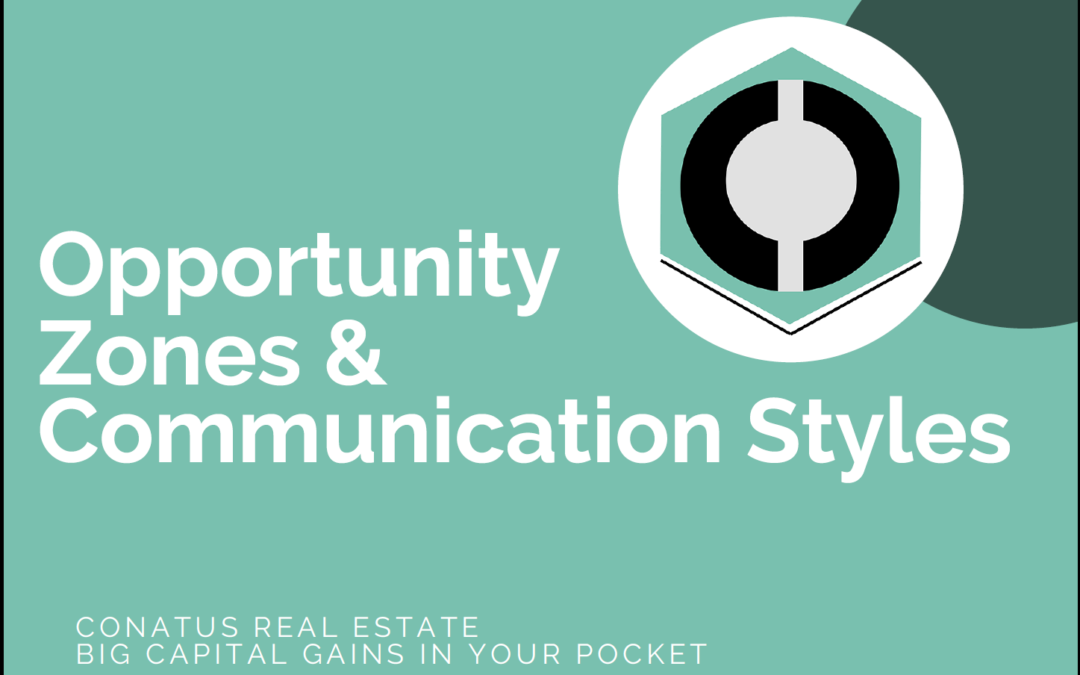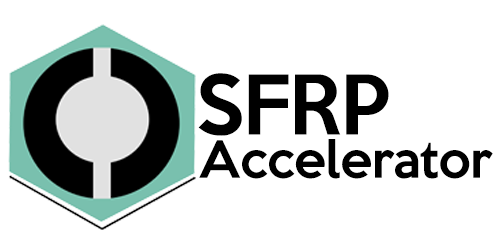Opportunity Zones and Communication Styles
Opportunity Zones are the latest and greatest thing to hit real estate investing. Understanding Communication Styles holds extreme value in everything we do as professionals, especially in real estate investing. This is a mashup presentation of the two.
FULL TRANSCRIPT
Good morning, good afternoon, good evening. My name is Ted Farry, I’m the president of Conatus Real Estate and I’m ecstatic to have you here for one more thrilling episode of real estate investing information. How many of you out there know what Opportunities Zones are? Hey, I like opportunity. I’m in the zone, right? Not Exactly. Today we’re going to do a mashup presentation of Opportunities Zones because they’re so popular in real estate investing and communication styles because it’s so important in how we interact as professionals, especially in real estate investing.
This table shows four different styles of communication and if you just want to break down some basics here, we have results driven over here on the left, relationship driven over here on the right, low energy and high energy. We’ll get into the details of each coming up here. Opportunities Zones are a federal regulation that allow for preferential tax treatment on specific investments and to distressed communities. It’s important to note that this is still getting clarified, and the next hearing is supposed to happen on February 14th, 2019. The direct communication style is what I scored highest on when I took a test about communication style. It’s actually important to note that when I took this test, the highest score that I had was in this dominant or direct style. My second highest score was in steady or supportive and the third highest was in influencer and initiating.
The important point to pull away from this is that well we might score highest in a specific communication style. We can still adapt to change our style to specific environments. This style direct communication is driven by decise, competitive, independent and confidence. We’re more concerned with results than relationships, and we prefer a fast paced busy environments. I went to Opportunity Zone conference a few weeks ago, such great content and it’s so complicated though, Opportunities Zones, everything related to it, it’s so complicated, and it’s not finalized yet. So this qualified investment, this is the one thing that I’m most comfortable presenting here. Once you’re allowed to invest into a qualified opportunity fund to gain the preferential tax treatment is the gain from a previous investment, and we have a very simple example here down at the bottom. Let’s say I bought Facebook and its IPO at $38 back in 2012, I decided to sell it yesterday for $165 this would give me a gain of $127.
Now this $127 that is the qualified investment amount, that’s what I could invest into a qualified opportunity fund to gain preferential tax treatment. It’s important to note that this is different from a 1031 exchange. Say this were a 1031 exchange scenario with real property instead of personal property, we would be required to invest this entire $165 into the 1031 exchange to get that to maximize that tax treatment. Anything less than that $165 would be taxed at the highest rate possible. This conference that I went to is so beneficial because of panels like this. You can see this panel full of straight face dudes. These guys, these four guys down here on the left, these are all attorneys and this guy over here, I think he was in private equity. Now for me, I was eating this up. This was great content, highly technical, but even for me, after an hour and a half of it, my brain started turning into a little bit of mush and I started to wander a little bit.
I started to think about what is the cost of this panel? Now I can’t imagine that any of these guys are such high value of content that they charge much less than a thousand dollars. Some of them might, maybe even more per hour. And we have our private equity guy, he’s taking 20% of everything. And so, we start to calculate the cost of this panel is probably over $7,000. Now, why is that so important? It’s so important because it’s expensive. It is expensive. And with the complexities associated with Opportunity Zones, you have to be careful that you don’t end up shifting any potential tax benefits that you’re going to create in this fund and paying it up front to our lawyers to figure it out. Now, is it worth it? Was the information valuable? Certainly. On this panel, these attorneys and private equity guy, we’re talking about things like qualified rehabilitation investments, structure. Here’s the slide they put up when they came to structure, so simple. Yeah, right. Extremely complex, I have no idea what’s going on in the slide.
And no one really has it figured out. That was a key takeaway from pretty much every panel at this conference is that if anybody tells you at this point that they have opportunities on this figured out, they may not be being truthful with you because it’s not set, nobody has it figured out yet. And one of the most concerning takeaways here is that California has not yet adopted the tax incentive plan created at the federal level. We’ll revisit this here in a second. This communication style, the analytical communication style that’s driven by precise analytical and logical. They don’t easily express emotions, I totally agree with that. This is the most straight faced panel I’ve ever seen in my life. They prefer a structured, ordered and functional environments. The next panel is a great example of initiating, or the influencer communication style. This panel had the new state treasurer, and I believe it was her assistant.
We’re keeping names out of here to stay out of the politics, but the most indicative thing that she said as far as her communication style is that she cued in on this statement that, California hasn’t yet adopted the tax benefits. And so she made the statement, “California does actually plan to align with the federal tax incentive plan. It’s on the budget.” Now, the crowd was extremely smart as well, and they kept on probing into that statement. It turns out that when she answered more questions on the budget meant that it still needs to go through the house and Senate. And so everybody’s hopes of just getting past, well, it’s not out of the question, but we all know what it’s like to have a bunch of politicians standing in the way of something that we want. This was indicative of this initiating communication style and that she wanted to build, to latch onto those relationships in the crowd so much that she took the risk of presenting this information in the most favorable light in order to achieve those relationships.
This communication style is sociable, enthusiastic, and spontaneous. They’re motivated by relationships. They’re high energy, and they prefer stimulating personal and friendly environments. The entire time on the panel, all they could talk about, I’ve been in office for two weeks, and it’s been nonstop. I’m going … High energy, high energy. You could tell that was their communication style preference. The next style we’ll talk about is a supportive communication style or steady. This was indicative by calm conversations that I had with investors in the hall. We can separate this into really two different types of investors. We have people with qualified investment dollars that are non operators, meaning that they don’t plan to go in and operate their properties. The tone of these conversations for pretty much all of them was wait, take your time and evaluate the universal fund opportunities. It may be very exciting, and it’s so popular right now, but there’s still a lot to be worked out. And of course the most important thing, run everything by your tax attorney.
Now the next group were investor operators. The key points here are keep the structure simple or risk that, our friends back here might take all of your tax benefits and fees up front. To do this, utilize your personal investments, or qualified investments from friends and family. It’s pretty much required to keep the structure simple and the most important thing, run everything by your tax attorney. This communication style is depicted by calm, sincerity, and being approachable. They’re motivated by close relationships and dislike conflict, and they prefer professional or personal relax and no tension environments. I can tell you that most of our, the relation, most of the communication that we have with our customers or clients and investors that we work with falls into this category. It’s calm, no rush, low tension types of communication, and it’s their long term. We’re both working to achieve longterm relationships that are based on sincerity and honesty.
In conclusion, we come back to our four different types. We have our influencer, which is really sales. We brought up a politician dominant, this is operations, conscientious, might be attorneys, probably IT, and our steady over here. This might be something like a human resources or something similar. And my most favorite line from any of the opportunities on slides that came up during this conference, get professional advice. We’d love to talk more with you about this, please feel free to reach out. Until next time.


